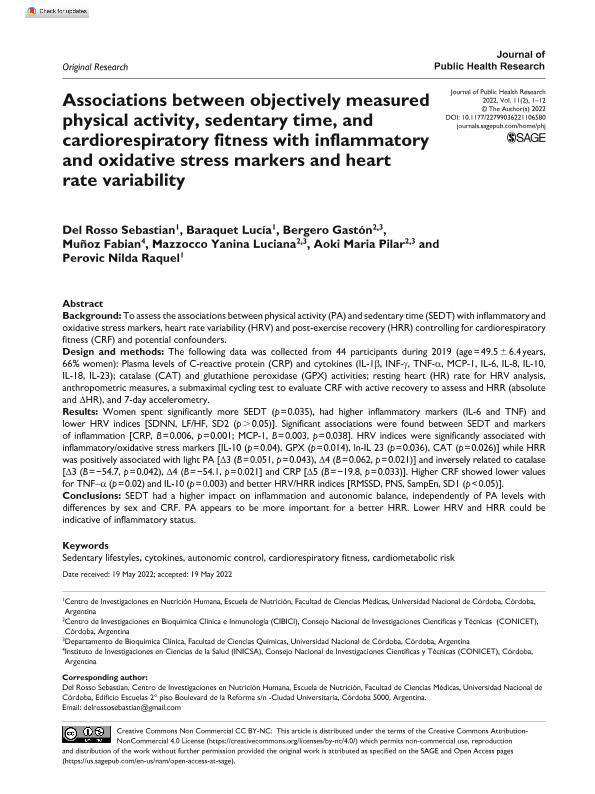Artículo
Associations between objectively measured physical activity, sedentary time, and cardiorespiratory fitness with inflammatory and oxidative stress markers and heart rate variability
del Rosso, Sebastián ; Baraquet, María Lucía
; Baraquet, María Lucía ; Bergero, Gastón
; Bergero, Gastón ; Muñoz, Fabian Leonardo; Mazzoco, Yanina Luciana; Aoki, Maria del Pilar
; Muñoz, Fabian Leonardo; Mazzoco, Yanina Luciana; Aoki, Maria del Pilar ; Perovic, Nilda Raquel
; Perovic, Nilda Raquel
 ; Baraquet, María Lucía
; Baraquet, María Lucía ; Bergero, Gastón
; Bergero, Gastón ; Muñoz, Fabian Leonardo; Mazzoco, Yanina Luciana; Aoki, Maria del Pilar
; Muñoz, Fabian Leonardo; Mazzoco, Yanina Luciana; Aoki, Maria del Pilar ; Perovic, Nilda Raquel
; Perovic, Nilda Raquel
Fecha de publicación:
07/2022
Editorial:
SAGE Publications
Revista:
Journal of Public Health Research
ISSN:
2279-9036
e-ISSN:
2279-9036
Idioma:
Inglés
Tipo de recurso:
Artículo publicado
Clasificación temática:
Resumen
Background: To assess the associations between physical activity (PA) and sedentary time (SEDT) with inflammatory and oxidative stress markers, heart rate variability (HRV) and post-exercise recovery (HRR) controlling for cardiorespiratory fitness (CRF) and potential confounders. Design and methods: The following data was collected from 44 participants during 2019 (age = 49.5 ± 6.4 years, 66% women): Plasma levels of C-reactive protein (CRP) and cytokines (IL-1β, INF-γ, TNF-α, MCP-1, IL-6, IL-8, IL-10, IL-18, IL-23); catalase (CAT) and glutathione peroxidase (GPX) activities; resting heart (HR) rate for HRV analysis, anthropometric measures, a submaximal cycling test to evaluate CRF with active recovery to assess and HRR (absolute and ΔHR), and 7-day accelerometry. Results: Women spent significantly more SEDT (p = 0.035), had higher inflammatory markers (IL-6 and TNF) and lower HRV indices [SDNN, LF/HF, SD2 (p > 0.05)]. Significant associations were found between SEDT and markers of inflammation [CRP, B = 0.006, p = 0.001; MCP-1, B = 0.003, p = 0.038]. HRV indices were significantly associated with inflammatory/oxidative stress markers [IL-10 (p = 0.04), GPX (p = 0.014), ln-IL 23 (p = 0.036), CAT (p = 0.026)] while HRR was positively associated with light PA [Δ3 (B = 0.051, p = 0.043), Δ4 (B = 0.062, p = 0.021)] and inversely related to catalase [Δ3 (B = −54.7, p = 0.042), Δ4 (B = −54.1, p = 0.021] and CRP [Δ5 (B = −19.8, p = 0.033)]. Higher CRF showed lower values for TNF-α (p = 0.02) and IL-10 (p = 0.003) and better HRV/HRR indices [RMSSD, PNS, SampEn, SD1 (p < 0.05)]. Conclusions: SEDT had a higher impact on inflammation and autonomic balance, independently of PA levels with differences by sex and CRF. PA appears to be more important for a better HRR. Lower HRV and HRR could be indicative of inflammatory status.
Archivos asociados
Licencia
Identificadores
Colecciones
Articulos(CCT - CORDOBA)
Articulos de CTRO.CIENTIFICO TECNOL.CONICET - CORDOBA
Articulos de CTRO.CIENTIFICO TECNOL.CONICET - CORDOBA
Articulos(CIBICI)
Articulos de CENTRO DE INV.EN BIOQUI.CLINICA E INMUNOLOGIA
Articulos de CENTRO DE INV.EN BIOQUI.CLINICA E INMUNOLOGIA
Articulos(INICSA)
Articulos de INSTITUTO DE INVESTIGACIONES EN CIENCIAS DE LA SALUD
Articulos de INSTITUTO DE INVESTIGACIONES EN CIENCIAS DE LA SALUD
Citación
del Rosso, Sebastián; Baraquet, María Lucía; Bergero, Gastón; Muñoz, Fabian Leonardo; Mazzoco, Yanina Luciana; et al.; Associations between objectively measured physical activity, sedentary time, and cardiorespiratory fitness with inflammatory and oxidative stress markers and heart rate variability; SAGE Publications; Journal of Public Health Research; 11; 2; 7-2022; 1-12
Compartir
Altmétricas



